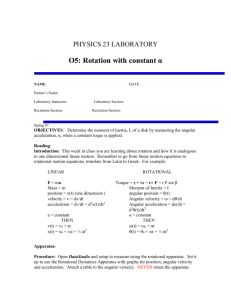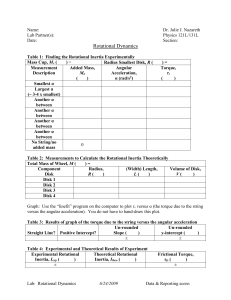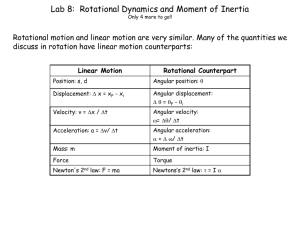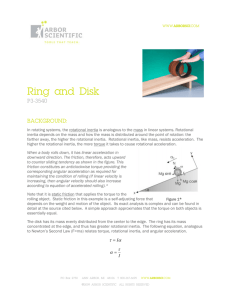Rotational Inertia Lab
advertisement
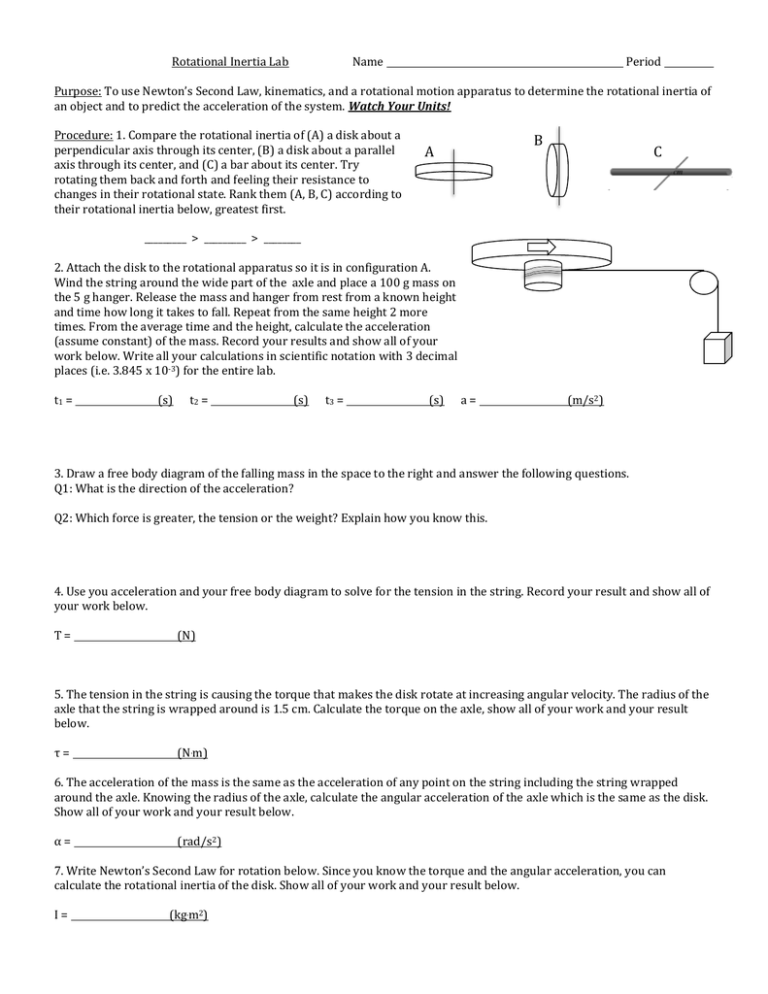
Rotational Inertia Lab Name Period Purpose: To use Newton’s Second Law, kinematics, and a rotational motion apparatus to determine the rotational inertia of an object and to predict the acceleration of the system. Watch Your Units! Procedure: 1. Compare the rotational inertia of (A) a disk about a perpendicular axis through its center, (B) a disk about a parallel axis through its center, and (C) a bar about its center. Try rotating them back and forth and feeling their resistance to changes in their rotational state. Rank them (A, B, C) according to their rotational inertia below, greatest first. B A C _________ > _________ > ________ 2. Attach the disk to the rotational apparatus so it is in configuration A. Wind the string around the wide part of the axle and place a 100 g mass on the 5 g hanger. Release the mass and hanger from rest from a known height and time how long it takes to fall. Repeat from the same height 2 more times. From the average time and the height, calculate the acceleration (assume constant) of the mass. Record your results and show all of your work below. Write all your calculations in scientific notation with 3 decimal places (i.e. 3.845 x 10-3) for the entire lab. t1 = (s) t2 = (s) t3 = (s) a= (m/s2) 3. Draw a free body diagram of the falling mass in the space to the right and answer the following questions. Q1: What is the direction of the acceleration? Q2: Which force is greater, the tension or the weight? Explain how you know this. 4. Use you acceleration and your free body diagram to solve for the tension in the string. Record your result and show all of your work below. T= (N) 5. The tension in the string is causing the torque that makes the disk rotate at increasing angular velocity. The radius of the axle that the string is wrapped around is 1.5 cm. Calculate the torque on the axle, show all of your work and your result below. τ= (N.m) 6. The acceleration of the mass is the same as the acceleration of any point on the string including the string wrapped around the axle. Knowing the radius of the axle, calculate the angular acceleration of the axle which is the same as the disk. Show all of your work and your result below. α= (rad/s2) 7. Write Newton’s Second Law for rotation below. Since you know the torque and the angular acceleration, you can calculate the rotational inertia of the disk. Show all of your work and your result below. I= (kg.m2) 8. Remove the disk and mount it so that it spins in configuration B. Repeat procedure steps 2-7 and determine the rotational inertia. Show all of your work and your results below. t1 = (s) t2 = T= (N) τ = (s) t3 = (N.m) α = (s) a= (m/s2) (rad/s2) I= (kg.m2) 9. The disk has a mass of 1.374 kg and a radius of 0.113 m. The rotational inertia of a disk spinning in configuration A is 𝐼 = 1 1 𝑚𝑟 2 and the rotational inertia of a disk spinning in configuration B is 𝐼 = 𝑚𝑟 2 . Calculate the rotational inertia of the disk 2 4 in each configuration. Compare them to those determined experimentally in steps 7 and 8. Give one specific reason for any differences. Most students find they overestimate I for configuration B. What factor might cause this that is not a factor for configuration A? Show all of your work below. 10. The bar has a mass of 573 g and a length of 50.7 cm. It can be approximated as a rod spinning about its center that has a 1 rotational inertia of 𝐼 = 𝑚𝑙 2 . Calculate the rotational inertia of the bar about its center. Revisit procedure step 1 and 12 check your ranking. Correct it if needed. Predict the time it will take the mass to fall 1.0 m using what you have learned in the previous steps. (Hint: use your equations from steps 4-7 and solve for the unknown acceleration of the falling mass) After you have made your prediction, time the fall of the mass. Calculate your percent error. Show all of your work and record your results below. I= (kg.m2) tpredicted = (s) tactual = (s) %Error = Conclusion: You probably noticed that the falling mass would hit the floor and stop, then rise back up. Explain how this is possible from an energy standpoint.
